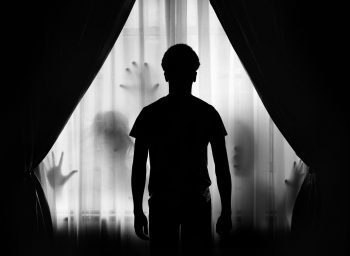By Mateo Sol
Guest writer for Wake Up World
“It is a frightening thought that man also has a shadow side to him, consisting not just of little weaknesses and foibles, but of a positively demonic dynamism. The individual seldom knows anything of this; to him, as an individual, it is incredible that he should ever in any circumstances go beyond himself. But let these harmless creatures form a mass, and there emerges a raging monster.” – Carl Jung, Psychology of the Unconscious
If you’re truly honest about self-exploration during your soulwork journey, you will come across many aspects and traits about yourself that you will find difficult – if not completely disturbing – to accept.
In the domain of psychology, renowned psychologist Carl Jung devoted a lot of thought to this problem of the “Shadow Self”, being deeply invested in the research of ancient esoteric knowledge and spiritual scriptures to not only treat the mind of man, but his soul as well.
[pro_ad_display_adzone id=”110028″]
In response to his serious preoccupation, Jung created the Archetypes model, a concept wherein he believed our unconscious minds are fragmented or structured into different “selves” in an attempt to organize how we experience different things in life. Two of Jung’s major Archetypes are The Persona and The Shadow Self.
The Birth of the Shadow Self
So what exactly is the “Persona” and “Shadow Self”? The Persona, according to Jung, defines what we would like to be and how we wish to be seen by the world. The word “persona” is derived from a Latin word that literally means “mask”, however in this instance, the word can be applied metaphorically, representing all of the different social masks that we wear among different groups of people and situations.
On the other hand, the Shadow Self is an archetype that forms part of the unconscious mind and is composed of repressed ideas, instincts, impulses, weaknesses, desires, perversions and embarrassing fears. This archetype is often described as the darker side of the psyche, representing wildness, chaos and the unknown. Jung believed that these latent dispositions are present in all of us, in many instances forming a strong source of creative energy.
We are all born pure, like blank canvases. But at some point during our childhood development, we learn knowledge that teaches us to separate things into good and evil. The moment we eat from this tree of knowledge, our shadows are born and we begin to divide ourselves. Furthermore, in our cultural ‘socialization’ process, we begin to sort out those traits within us that are acceptable in society, and those unacceptable traits that aren’t (which are later hidden away). As Jung said:
“What we call civilized consciousness has steadily separated itself from the basic instincts. But these instincts have not disappeared. They have merely lost their contact with our consciousness and are thus forced to assert themselves in an indirect fashion. This may be by means of physical symptoms in the case of a neurosis, or by means of incidents of various kinds, or by unaccountable moods, unexpected forgetfulness, or mistakes in speech… Modern man protects himself against seeing his own split state by a system of compartments. Certain areas of outer life and of his own behavior are kept, as it were, in separate drawers and are never confronted with one another.”
Thus, the dark shadow traits that we all possess accumulate in the corners of our unconscious minds, never becoming adequately integrated into our conscious minds because we never see our split state in the first place (due to our psychological ‘defense mechanisms’). And so we continue on accumulating these dark desires, motivations and fears.
This can be dangerous. Through observing many of our soulwork students for example, I’ve come across certain individuals who have allowed their Shadow Selves to accumulate for so long that they’ve erupted and overpowered the person through depression or an unconscious accident that ended up manifesting their inner “Monsters”. This can lead to physical, emotional, psychological and interpersonal consequences that can last for a very long time.
Repression of the Shadow Self
It’s understandable that our civilizing process requires us to repress aspects of ourselves that do not fit in with the structured ideal of our society. We are born whole and complete, but slowly we learn to live fractioned lives, accepting some parts of our nature but rejecting and ignoring other parts.
A holiday to a different part of the world will show you how arbitrary some of these divisions are. In the West for example, eye contact is perceived as confident and engaging, whereas in Japan it’s perceived as arrogant and rude. In the Middle East burping after a meal is a sign of pleasure, yet anywhere else in the world it’s seen as vulgar and uncouth. And in American TV shows depicting violent murders is considered more acceptable than showing nudity or sexual acts, whereas in Europe it’s the complete opposite. These are just a few examples.
Basically, the repression of our negative traits or emotions in society is one of the biggest barriers in any persons journey towards Self-Love and living authentically. How can you completely and wholeheartedly accept who you are if there are sides of yourself that you’re too afraid to explore?
Don’t get me wrong, the idea of the “Shadow Self” doesn’t only apply to psychology. Many ancient Shamanic teachings, including the ones I was taught in, involved the preparation towards an illness or a spiritual death (by ascending into your own darkness or “Shadow Self”), and being reborn in an attempt to provide you with the experience and insight to heal yourself and bring that healing wisdom to the people of your tribe.
So, apart from modern day society’s ideas of acceptable and non-acceptable behavior, what else causes such a great repression of the Shadow Self? In truth, a lot of it actually comes from the endless cornucopia of “feel good” motivational teachings out there. If you notice, a lot of modern spiritual and religious work revolves around moving towards the “light”, accepting the “light” and seeking for the “light”. Yet by doing so, we ignore the entirety of what it is to be human! In fact, many of the spiritual and new age teachings out there provide an escape for those who do not want to be responsible for the entirety of themselves and their lives. Understandably the “light” energies are usually represented with noble values such as love, peace, joy, harmony, compassion, entirely ignoring the darker elements within us such as anger, vengeance, control, fear, shame, competitiveness, jealousy, lust, etc. Because these darker characteristics are associated with ‘negativity’, they’re avoided out of fear.
[pro_ad_display_adzone id=”110030″]
Interestingly, many seekers of spiritual growth think that somehow all of the negative qualities within themselves will eventually be transcended. Yet from my own experience, embracing your inner darkness allows for the creation of a psychological and spiritual balance, an integrated whole – whereas denying it creates chaos and disharmony.
The keyword here is “integrate”, which comes from the Latin word integratus, meaning to ‘make whole’. To integrate an inner quality is to take ownership and responsibility for it, rather than rejecting or denying it. The benefits are many; sanity, healing, and wholeness are all found in integration. On the other hand, the opposite of integration is to ‘disintegrate’ – or to be fragmented and divided into pieces. A person that ‘breaks down’ or ‘falls apart’ for instance, is someone who has been unable to handle stress and who has ignored too many of their personality traits, especially Shadow Self traits. In reality, a fragmented person can never handle adversity because they have no whole center, and they’re always handling life from the corners of their personality parts.
The Right and Left Handed Paths
In esoteric branches of Hinduism such as Tantra, or Western Esoteric Occult teachings, they have what is called Right and Left handed paths towards the Higher Self. Throughout history, the left has always been associated with dark, radical or sinister elements. Even the etymology of the word “sinister” means “from the left side”. Also, in Muslim, Chinese, Judeo-Christian and even Hindu religions the left hand is associated with being the unclean one, which is most likely why some of these cultures use it to wipe their… behinds! Interestingly, British studies in the 1970’s found that there had been an increase in the number of left-handed people compared to previous generations, suggesting that many left-handers had taught themselves to be right-handed for social, religious or practical reasons.
These days, the “right-handed path” is what most of us understand to be the pursuit for positive things such as overcoming personal flaws and limitations, purifying our sins and anything else that helps us connect to our “higher selves”. The left-handed path, however, is associated with parts within us that are typically fought against, rejected, denied, feared, and thus it becomes our biggest inner hindrance, but at the same time, the key to our liberation.
The truth is that we have both hands, not just one, and we must learn to use them in a balanced way if we seek to live a balanced life. The Right hand seeks to improve the personal self, overcome its flaws, but the Left hand seeks investigation, seeks to be ‘selfish’ in its pursuit of Self-Love. Just like in the Yin and Yang, when you reach a deep balance, suddenly the dichotomy of right and left will disappear.
Personally, I like to think that first there was darkness. Unlike light, darkness is infinite. Under every rock, you will find darkness, but light and darkness need each other to come into existence. Unless you learn to first embrace that darkness within yourself, you can never pursue the light of Self-Love in a balanced way.
Many new age teachings talk about leaning towards the “higher chakras” and avoiding the lower ones. However, in the long term, this won’t be very helpful. Unless the foundation of your home is solid and stable, no matter how beautifully you decorate and work on the house itself, sooner or later your house will collapse and crumble down.
Embracing the Shadow Self
Our journey of Self-Exploration is a bit like Dante’s Inferno. Before making our way out of “hell” we must walk through the depths of our inner darkness. Many religions symbolize these experiences well. Two famous examples include the case of Jesus who had to face Satan in the desert, and Buddha’s encounter with Mara (the Buddhist Satan) before his “awakening”.
When I write about embracing or integrating your shadow self, I do not mean to indulge in any desire that arises within you. Indulging your anger, for instance, will simply result in more anger. By embracing your inner darkness I mean that it is necessary for you to “accept” it. Accepting your darkness will allow you to take responsibility for yourself, and once you truly acknowledge one of these dark traits instead of avoiding them, suddenly, they will stop having control over you. By being honest with ourselves and accepting our shadow elements, it frees us up to truly witness the uncharted areas of our minds, allowing us to see that we are not these elements, but simply possess thoughts, feelings and drives that come and go. You cannot simply go “beyond hatred” if first you don’t admit to yourself that you do in fact possess hateful feelings.
To completely experience Self-Love we must learn to experience our Shadow Selves, and voyage into the dark, murky waters of the unknown courageously. Otherwise, every time we condemn other people for their shadow traits, we’re in essence condemning our hypocritical selves in the process.
A whole and balanced self is a reconciliation of all parts, an inner unification. It is not an indulgence of the darker parts of our natures, but an acceptance and direct experience of them in the light of mindful awareness and deep honesty. This is the entire opposite of many self-denying traditional spiritual methods of subduing, denying, or ascetically disciplining the self. To live differently, as is the aim and motivation of LonerWolf, is to be authentic. And in order to be authentic we have to embrace our inner selves – that which is culturally uncommon or bizarre.
It’s astounding to realize that often the mundane characteristics in people are the ones that are socially acceptable. In essence, any “primitive” traits within us get sent to our Shadow Selves, but at the same time, any creative, unique, innovative and different ideas also get sent to our Shadow Selves because they’re not socially acceptable.
Exploring your darkness is not necessarily all doom and gloom. In fact, you may be surprised by the endless array of creative and interesting ‘things’ you find that have been secretively stored away.
To accept and embrace your Shadow Self is to go back and become “whole” again and thus taste a glimpse of what authentic “holiness” feels like.
Also by Mateo Sol:
- Spiritual Sex: 3 Types of Divine Union
- 6 Powerful Solfeggio Frequencies that Raise Your Vibration
- Hypnagogia: The Trippy Mental State That is the Key to Deep Self-Discovery
- 39 Self-Care Ideas for Those Who Struggle with Self-Love
- Signs and Omens: Listening to the Messages of Spirit
- 21 Signs You’re Experiencing “Soul Loss”
- Soul Retrieval Can Heal Addiction, Trauma and Mental Illness – Here’s How
- Mind, Self, Spirit and Soul: What’s the Difference?
- Why You Need to Forget Positivity, Keep Your Ego and Embrace Your Darkness
About the author:
Mateo Sol is a prominent psychospiritual teacher whose work has influenced the lives of thousands of people worldwide. Born into a family with a history of drug addiction, schizophrenia, and mental illness, Mateo Sol was taught about the plight of the human condition from a young age. As a spiritual guide and teacher, Sol’s mission is to help others experience freedom, wholeness, and peace in any stage of life. See more of his work at lonerwolf.com.
This article Shadow Self: Embracing Your Inner Darkness was originally published on lonerwolf.com.
[pro_ad_display_adzone id=”110027″]








